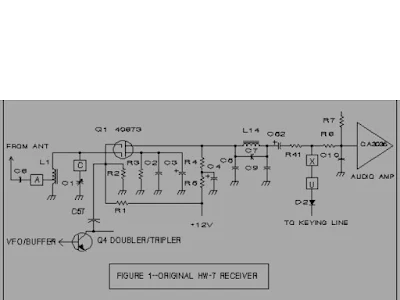 My HW-7 benefactor, Mike, WA3O, sent me some files related to this rig. Above, the original receiver. Very simple. Note the 40673 dual-gate MOSFET (often used by Doug DeMaw). The 40673 was implicated in quite a bit of square law detection of shortwave broadcast signals. I don't seem to be having much trouble with this -- could this be the result of the demise of many of the powerful SW broadcast stations? Perhaps the old, standard HW-7 receiver should be given another chance... As I type, I'm listening to 40 meters with this circuit and signals are just pouring in. It works just fine.
My HW-7 benefactor, Mike, WA3O, sent me some files related to this rig. Above, the original receiver. Very simple. Note the 40673 dual-gate MOSFET (often used by Doug DeMaw). The 40673 was implicated in quite a bit of square law detection of shortwave broadcast signals. I don't seem to be having much trouble with this -- could this be the result of the demise of many of the powerful SW broadcast stations? Perhaps the old, standard HW-7 receiver should be given another chance... As I type, I'm listening to 40 meters with this circuit and signals are just pouring in. It works just fine. Here is one of the many mods recommended for the receiver in this rig. I like this one too -- those SBL-1 devices are very nice. They look like ICs, but they are REALLY simple and you can crack them open and see their innards.

Our book: "SolderSmoke -- Global Adventures in Wireless Electronics"http://soldersmoke.com/book.htmOur coffee mugs, T-Shirts, bumper stickers: http://www.cafepress.com/SolderSmokeOur Book Store: http://astore.amazon.com/contracross-20
I just got an HW-7 last weekend at the Peoria Superfest for $25. I'm going to give it a go after I make sure it works as-is first.
ReplyDeleteIf you're going to do the mod it might be fun to make it switchable. Then you can really compare the before/after performance.
ReplyDeleteBill,
ReplyDeleteI suspect that you are correct that the lack of SWBC superstaions near our bands probably helps regarding the HW-7 receiver. In some ways, it's funny to hear you speak of the rig in such pleased terms. The HW-7 was my very first QRP rig and very nearly was my last. I got it shortly after I got my ticket back when I was still in high school in the early 90s. I remember it being a nightmare to use. I could barely hear anything on it other than local AMBC bleedthru and never did make any QSOs. I'm sure part of the problem was my complete lack of knowledge about the hobby at the time, but it sure left a bad impression. :)
My latest creation, the CC-Series (thanks for the very nice mention on the last episode BTW), uses a modern dual-gate MOSFET (BF998) as both the mixer and product detector. Having experimented with this part in a fair number of radios now, I can see the huge glaring hole in the HW-7 schematics. The front-end filtering is atrocious. A single tuned circuit, not even fronted by a low-pass filter. That DG MOSFET is amplifying all of the unwanted energy getting through the single tank circuit. That's not going to sound very pretty under anything other than ideal condx regarding nearby QRM. Other than the poor filtering, I don't think there's anything inherently wrong with that type of front end (as you said DeMaw used 'em, so they can't be that bad). You just have to know the limitations of your devices.
Thanks for the interesting topic!
73,
Jason NT7S
Bill
ReplyDeleteI ordered one of the first HW-7's when Heathkit introduced it. I made many enjoyable QSO's with it with in the military from 72-76. A couple of years ago I bought another one and wrote a subjective comparison which can be seen at http://pgerhardt.blogspot.com/search/label/HW-7
The Willamette 20 has a better DC rx but the HW-7 was always quite usable for me and in my recent test it is really not THAT much worse than the HW-8.
Tuned antennas were helpful as I remember.
73,
Paul K3PG
PS I continue to count on you to help us hold the value of my 'retirement' portfolio consisting of not one but two copies of SSDRA and a complete Drake 2B, 2BQ.